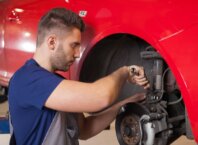Smooth driving is a balancing act that requires getting the wheels and tires to rotate at high speeds without vibrations. That’s not a slam dunk; a dirty little secret about wheels and tires is that they usually aren’t perfectly round, even when brand new. What’s more, their weight often isn’t evenly distributed, so they’re heavier in some spots than others.
Either issue can cause annoying vibrations. Out-of-balance tires can also cause rapid tire or suspension wear, so it’s not just about ride comfort.
That is why when new tires are mounted on wheels they’re spin-balanced to detect vibrations. Some vibrations can be eliminated by rotating the tire on the wheel so the heavy or “high” spot is in a different location that better matches up with the wheel. Small weights are attached to the wheels with adhesives or clips to counteract the heavy spots and provide a smooth ride. Over time, though, the weights can fall off. If that happens to a front wheel, you may feel vibrations through the steering wheel that typically become more pronounced as vehicle speed increases.

Many tire dealers include free lifetime rotation and balancing with new tires (something you should ask about before buying). Tire rotation is when the vehicle’s tires are removed and reattached at a different position to ensure they wear evenly, which should be done every 5,000 to 7,500 miles on most vehicles, or according to the automaker’s recommendation.
Many consumers neglect the balancing part and have their tires rotated only periodically. If balancing was included with the tires, it would be wise to remind the shop to check the balance at the same time. Even if balancing costs extra, it’s a good idea to have it checked at least every two years, or more often in areas where roads are not well-maintained.
Vibrations can also be caused by a bent wheel, a damaged tire (which won’t be fixed by balancing), worn suspension parts or worn wheel bearings, so balancing the wheels and tires may not eliminate all vibrations.
Tires and wheels are balanced before being attached to the vehicle by spinning them on a balancing machine that identifies heavier or stiffer spots that cause vibrations. Some tire dealers and repair shops use “road force” balancing machines that simulate the weight and forces applied to tires and wheels during driving conditions. They say this method provides more accurate and detailed readings that allow more precise balancing.
Source: https://www.cars.com/articles/how-often-should-tireswheels-be-balanced-1420681259118/







